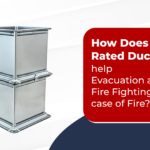Why Do We Need Fire Dampers?
How Fire Dampers Help During a Fire Emergency
In any modern building, safety is a top priority—and fire protection is one of the most crucial elements of it. Fire dampers are essential safety devices installed within HVAC duct systems that play a silent yet powerful role in controlling the spread of fire and smoke. But why exactly are they needed, and how do they protect us in an emergency? Let’s explore.
Prevents the Spread of Fire Through Ducts
When a fire breaks out, flames and smoke can quickly travel through the ventilation system. Fire dampers automatically close when they detect rising temperatures, effectively sealing the duct and blocking the fire from spreading to other rooms. This gives occupants more time to evacuate safely and limits the damage caused by the fire.
Enhances Overall Building Safety
Fire dampers protect not just people, but also the building’s infrastructure. By isolating fire to a specific zone, they help minimize destruction to critical systems and structural elements. Buildings without fire dampers are at higher risk of rapid fire spread, making them less safe for both occupants and emergency responders.
Supports Compliance with Fire Safety Codes
In India and globally, building regulations and fire codes often mandate the use of fire dampers in commercial, industrial, and residential structures with HVAC systems. Installing and maintaining these dampers ensures that your property complies with fire safety laws and avoids costly penalties or delays during inspections.
Maintains Safe Indoor Air Quality During Emergencies
In the case of a fire, smoke inhalation poses a major risk. Fire dampers close off ventilation paths, reducing the circulation of toxic smoke through the air conditioning ducts. This simple mechanism can make a huge difference in air quality and safety during a critical time.
Automatic Activation with Minimal Maintenance
One of the key benefits of fire dampers is their automatic functionality. They are equipped with a heat-sensitive fusible link that melts when the temperature reaches a set point, usually around 74°C (165°F). This triggers the damper to close instantly. With regular inspections and minimal maintenance, these devices can offer long-term protection without frequent intervention.
Ideal for Commercial and Industrial HVAC Systems
Buildings like malls, hospitals, offices, and hotels rely heavily on centralized HVAC systems. In these settings, fire dampers are not optional—they’re necessary for ensuring that a fire in one section doesn’t compromise the safety of the entire structure. For HVAC engineers, incorporating fire dampers is a standard best practice for building safety design.
Conclusion
Fire dampers may not be visible in your building, but their role in fire protection is invaluable. By containing fire, blocking smoke, and securing ventilation systems, they protect lives, property, and ensure compliance with safety norms. Investing in high-quality fire dampers is a smart and responsible step for any building project.
They not only help in minimizing fire-related damage but also support safer evacuation, protect critical assets, and provide peace of mind to building owners, tenants, and facility managers. In today’s fast-growing urban environments, integrating fire safety solutions like fire dampers into HVAC systems is not just a recommendation—it’s a necessity for every modern structure.


